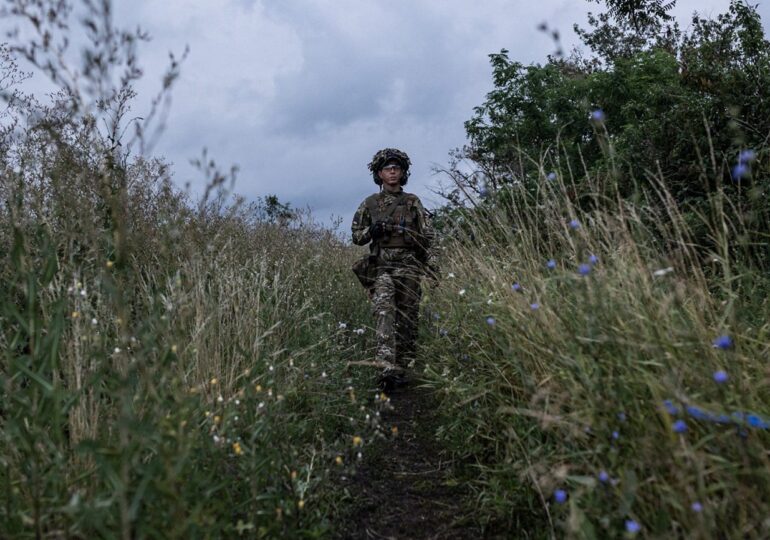The New York Times published a report on Saturday from the Russian region of Kursk, near the border with Ukraine, in areas reclaimed by Russian forces. The article has sparked disapproval from authorities in Kiev, accusing the American newspaper of spreading Russian propaganda.
The author of the article, Nanna Heitmann, traveled to the Kursk region accompanied by fighters from the special unit Ahmat, a Chechen formation fighting for Russia. The soldiers were tasked with evacuating civilians from the area.
"Last year, Ukraine turned a corner of Russia into a battlefield. Now it is a place of devastation and death," is the beginning of the report titled "A landscape of death: What remains where Ukraine invaded Russia".
"When I visited the area in March, the fields were strewn with cow and pig carcasses, as well as with the bodies of civilians and soldiers. The visible uniforms of the fallen were mostly Russian," the article states.
NATO and Ukraine are to blame
The author mentions that "the fighting has taken a toll on civilians trapped here for months, including from Russian army bombardments."
Heitmann writes that the destruction has fueled the anger of the local community not only towards the Russian authorities but also towards Ukraine and its Western allies.
She describes the Kursk region as "a rare place in this war where Russian civilians were under the control of Ukrainian forces, while extensive areas of Ukraine remain occupied by Russia."
However, she does not mention civilian casualties or the destruction caused by the Russians in Ukrainian territories, nor does she specify that Ukrainian military operations in the Kursk region were a response to years of unprovoked Russian aggression, a point that has displeased Kiev.
Heitmann quotes a local woman who says that Ukrainians could not reach Moscow, so they "hit their neighbors," claiming that "half of our relatives are Ukrainian."
Another local resident blames NATO's expansion for the war and describes Ukrainians as "victims of propaganda who blamed" Russian leader Vladimir Putin.
Chechnya, an example of Russia's "goodness"
The article states that Russian officials and media blame Ukraine for the deaths of civilians in the Kursk region. Instead, a statement from Ukraine's defense forces is presented, asserting that Ukrainian troops fully respected international law during the operation in Kursk.
The journalist adds that the individuals she spoke with in Sudja, "during the occupation," generally described the behavior of Ukrainian troops as respectful, mentioning some cases of medical and other assistance.
By occupying territory in the Kursk region, Ukrainian forces aimed "to distract Russian soldiers from the fighting inside Ukraine and provide a bargaining chip for future negotiations," she mentions.
Locals hoped that American President Donald Trump would "impose peace" and are now expecting Putin to fulfill his promises to rebuild the Kursk region. One resident cites Chechnya as an example, saying it was destroyed by Russian forces and later transformed into one of Russia's "most modern cities."
A significant part of the article focuses on accounts from fighters of the Ahmat unit who recount how they infiltrated the town of Sudja through a gas pipeline. "For the first time in my life, I saw civilians coming out to meet us, embracing us, crying," unlike the treatment they usually received as occupiers in Ukraine.
Kiev reminds of the American voice of the Soviets
The Ministry of Foreign Affairs of Ukraine criticized the report, labeling it as a manipulation comparable to the work of Walter Duranty, an Anglo-American journalist known for his pro-Soviet reports after the Bolshevik victory in the Russian Civil War.
Duranty headed The New York Times' Moscow bureau from 1922 to 1936. He conducted an exclusive interview with Joseph Stalin in 1929 and won the Pulitzer Prize in 1932 for his reports from the Soviet Union. In his articles, he vehemently denied the existence of the Holodomor, the famine caused by Soviet authorities that decimated the Ukrainian population.
Heorhii Tîhîi, the spokesperson for the Ukrainian Ministry of Foreign Affairs, expressed outrage at this article. "Anyone at The New York Times who thought it was smart to report alongside Russian war criminals made the stupidest decision. This is not balance or 'the other side of the story.' It means we are simply allowing Russian propaganda to mislead the public. It's sad to see Duranty-level manipulation return to the NYT," he conveyed in a post on X.

